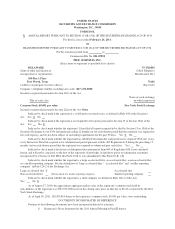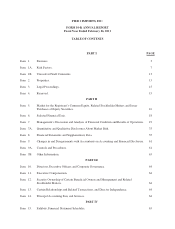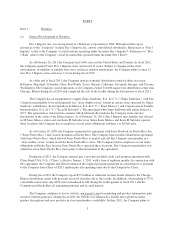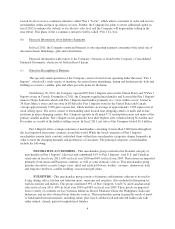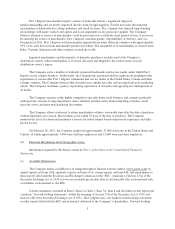Pier 1 2011 Annual Report Download - page 17
Download and view the complete annual report
Please find page 17 of the 2011 Pier 1 annual report below. You can navigate through the pages in the report by either clicking on the pages listed below, or by using the keyword search tool below to find specific information within the annual report.other retailers are liquidating merchandise for various reasons. If the Company is unable to maintain a
competitive position, it could experience negative pressure on retail prices and loss of customers, which in turn
could result in reduced merchandise margins and operating results.
The Company’s business is subject to seasonal variations, with a significant portion of its sales and
earnings occurring during two months of the year.
Approximately 25% of the Company’s sales generally occur during the November-December holiday
selling season. Failure to predict consumer demand correctly during these months could result in lost sales or
gross margin erosion if merchandise must be marked down significantly to clear inventory.
The Company’s business may be harmed by adverse weather conditions and natural disasters.
Extreme or undesirable weather can adversely affect customer traffic in retail stores as well as customer
shopping behavior. Natural disasters such as earthquakes, weather phenomena, and events causing infrastructure
failures could adversely affect any of the Company’s retail locations, distribution centers, administrative
facilities, ports, or locations of its suppliers domestically and in foreign countries.
Risks Associated with Dependence on Technology
The Company is heavily dependent on various kinds of technology in the operation of its business.
Failure of any critical software applications, technology infrastructure, telecommunications, data
communications, data storage facilities, or networks could have a material adverse effect on the Company’s
ability to manage the merchandise supply chain, sell merchandise, accomplish payment functions, report
financial data or manage labor and staffing. Although the Company maintains off-site data backups, a
concentration of technology-related risk exists in the Company’s headquarters located in Fort Worth, Texas.
Failure to protect the integrity and security of individually identifiable data of the Company’s customers
and employees could expose the Company to litigation and damage the Company’s reputation.
The Company receives and maintains certain personal information about its customers and employees.
The use of this information by the Company is regulated at the international, federal and state levels, as well as
by certain third party contracts. If the security and information systems of the Company or of its business
associates are compromised or our business associates fail to comply with these laws and regulations and this
information is obtained by unauthorized persons or used inappropriately, it could adversely affect the Company’s
reputation, as well as operations, results of operations and financial condition, and could result in litigation
against the Company or the imposition of penalties. As privacy and information security laws and regulations
change, the Company may incur additional costs to ensure it remains in compliance.
Regulatory Risks
The Company is subject to laws and regulatory requirements in many jurisdictions. Changes in these
laws and requirements may result in additional costs to the Company, including the costs of compliance as well
as potential penalties for non-compliance.
The Company operates in many taxing jurisdictions, including foreign countries. In most of these
jurisdictions, the Company is required to collect state and local sales taxes at the point of sale and remit them to
the appropriate taxing authority. The Company is also subject to income taxes, excise taxes, franchise taxes,
payroll taxes and other special taxes. The Company is also required to maintain various kinds of business and
11


